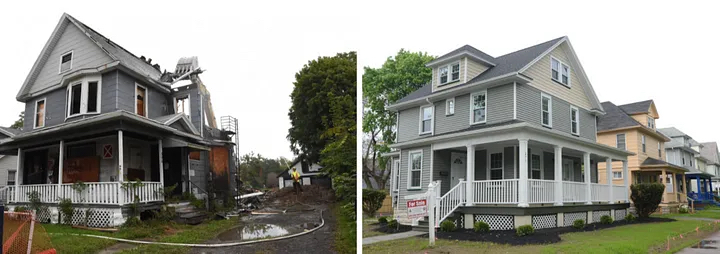Rochester, New York, USA
Project Type:
Community Engagement, Economic Development, Finance, High-Performing Government, Housing

2024 Gold Certification
Rochester, New York, is making transportation work better for everyone. One out of every four households in Rochester does not have a car and relies on walking, biking and public transportation for daily travel. In 2023, the City used geographic and demographic data to develop an Active Transportation Plan to improve safety and accessibility for pedestrians, cyclists and transit riders. In 2024 the City began connecting 60 miles of bike paths to increase accessibility for residents, and the data-backed plan was awarded a federal Safe Streets for All grant for $23.7 million. Furthermore, Rochester continues its commitment to leveraging disaggregated data, through its first Disaggregated Data Standard with What Work Cities’s support.

2021 Silver Certification
Used a range of qualitative and quantitative data sources, including City-owned and U.S. Census data, to understand the housing market’s structural challenges to help develop affordable and market-rate housing units.
Used data-driven approaches to support projects in vulnerable neighborhoods and targeted investments to help stabilize home values and promoted long-term investments to the community.
Displayed housing data in Rochester’s Development Opportunity Sites initiative so that residents can understand how their government is working to attract businesses and produce more affordable housing and view a GIS-based map detailing investment projects.
Solving the Housing Crisis with Data
In many U.S. cities, residents face rising rents and home prices that put affordable housing out of reach. But Rochester, New York’s housing crisis is different. The city is a soft market in which supply exceeds demand. Median housing costs for homeowners and renters are significantly lower in Rochester than in New York State and nationwide, but high poverty rates and very low incomes still create major affordability challenges. There’s also a basic quality problem: An aging housing stock requires maintenance and upgrades.
“We have one of the oldest housing stocks in the country,” says Elizabeth Murphy, associate planner and administrative analyst in Rochester’s Office of City Planning. Nearly two-thirds of housing units in the city were built prior to 1950 and nearly 90 percent were built prior to 1980.
“That means a lot of deferred maintenance and healthy housing needs.” In many parts of the post-industrial city, houses have deteriorating roofs and mechanicals, as well as lead paint and asbestos. Renovation and remediation needs are high, but given low home values and high poverty rates, rehab or redevelopment at the scale that is needed only makes financial sense with “significant subsidies” in the mix, Murphy notes.

Rochester’s 2018 citywide housing market study, its first in more than a decade, crystallized officials’ understanding of the housing crisis. Drawing on a range of qualitative and quantitative data sources, including City-owned and U.S. Census data, the study painted a detailed picture of the housing market’s structural challenges as well as key market interventions the City could pursue to help develop both affordable and market-rate housing units. City leaders incorporated the data-driven housing analysis and recommendations into its new 15-year comprehensive plan, Rochester 2034, adopted by City Council in 2019.
“The housing study made the challenges of our market context clear,” says Kevin Kelley, manager of planning. “It also made clear that we need to strategically engage that reality to help reposition and revitalize our neighborhoods.”
Like the housing study, Rochester 2034’s blueprint for growth and development reflects the City’s commitment to foundational data-driven practice areas including stakeholder engagement, performance & analytics, and data governance. It draws on input gathered from over 4,000 community members and over 100 stakeholder groups to set specific, achievable goals across a range of areas — transportation, economic growth and housing among them. Recognizing that Rochester’s housing challenges are multidimensional, the Plan envisions the City playing multiple roles to spark and sustain positive change.
“There’s a spectrum of roles local governments can play with housing,” Kelley says. “In some instances it serves as a charitable giver and in others it plays the role of strategic investor. There’s a time and a place for each.”
As examples of the former, the City serves hundreds of low-income households each year through grants to pay for housing rehab, new roofs, emergency furnace/boiler/water heater repairs, and addressing lead hazards in pre-1978 housing units. As a strategic investor, the City is looking to take a data-driven approach to support projects in so-called “middle markets.” These are defined as neighborhoods vulnerable to decline where targeted investments could help stabilize home values and promote long-term benefits to the community.

Rochester 2034’s Housing Action Plan set six overarching goals with 37 specific strategies recommended for implementation. Staff track progress on the goals by updating a shared internal reporting site. In its first Two-Year Progress Report since Plan adoption, the City reports that work has been completed on one of the 37 housing strategies and is underway (i.e., “started” or “ongoing”) on 28 of them. Reports that describe overall progress on Plan implementation and provide detailed status updates on specific strategies will be released to the community every two years through 2034.

Leveraging RFPs and City-Owned Land to Catalyze Change
One of the Plan’s housing goals was to support the production of new high-quality, mixed-income housing that is both affordable and accessible to people across a wide range of incomes, abilities, household sizes, and ages. Rochester’s annual budget now sets specific targets for the number of affordable and market-rate units the City will create; current fiscal year goals are 152 and 103, respectively.
To spur production of units, the City updated its annual Housing Development request for proposals (RFP) requirements for any organization (whether for-profit or otherwise) seeking financial support from the City or looking to buy vacant City-owned land for a housing project. As of this year, to garner City support, developers of market-rate mixed-income projects that do not qualify for affordable housing subsidy programs administered by New York State have to make at least 20% of housing units affordable to individuals or families earning at or below 60% of the area’s Median Family Income (MFI).

The Rochester 2034 plan has also jump-started more strategic approaches to developing vacant lots; the City owns thousands of parcels across Rochester. City officials are working to customize redevelopment goals and RFPs for City-owned land to better reflect market context, with the goal of stimulating neighborhood development in more targeted ways. In low-demand areas, which tend to be lower-income, parcels may be reserved for businesses that will create durable jobs and thereby stimulate demand for housing. But if the parcel is in a higher-market area, the city may want to use the RFP to spur affordable and mixed-use development.
“We’re taking a more customized approach in how we think about land use and our role as a strategic investor. A basic goal here is to provide more jobs, with better wages, so housing options can become more in reach for folks.”
Because Rochester’s affordability challenges are rooted in very low incomes, its housing strategy and economic development strategy need to dovetail.
This is on display in Rochester’s Development Opportunity Sites initiative that markets 12 City-owned sites which, officials believe, are well-positioned to help revitalize surrounding neighborhoods. While those sites await buyers, residents interested in understanding how their government is working to attract businesses and produce more affordable housing can view a GIS-based map detailing projects the City has invested in during the last 10 years.
“We’re proud of the progress we’ve made in embedding data-driven governance practices into our culture and grateful to What Works Cities for its support. There’s been a valuable shift in how we think about housing challenges and pursue solutions. In the coming years, I expect our new strategies will deliver more and more results to residents.”